 ヴァーチャル・リアリティ
ヴァーチャル・リアリティ 
 ヴァーチャル・リアリティ
ヴァーチャル・リアリティ 
virtual reality

日本語のウィキペディアにはこうある:「ヴァーチャル・リアリティ」あるいは「バーチャル・リアリティ(英: virtual reality, VR)とは、現物・実物(オリジナル)ではないが機能としての本質は同じであるような環境を、ユーザの五感を含む感覚を刺激することにより理工学的に作り 出す技術およびその体系」。この定義は、「技術やその体系」が何を示しているのか不明瞭なため、完全に役立たずの定義である。むしろ有害であるといっても よい。
英語は多少まともか、VRは「実際の世界と類似のあ るいは完全に異なる、あるシミュレート[偽装化]された経験」とクリアに定義している。つまり、
"Virtual reality (VR) is a simulated experience that can be similar to or completely different from the real world. Applications of virtual reality can include entertainment (i.e. video games) and educational purposes (i.e. medical or military training). Other, distinct types of VR style technology include augmented reality and mixed reality." - virtual reality.
バーチャルリアリティ(VR)とは、現実世界と似ていることもあれば、 まったく異なることもある疑似体験のことである[つまり可能的であることがすべて触知される形で呈示されている]。バーチャルリアリティの用途には、娯楽(ビデオゲームなど)や教育目的(医療や軍事訓練な ど)がある。VRスタイルの技術には他に、拡張現実(AR)や複合現実(MR)などがある。(→2つの経験の融合あるいは混同のことを「ヴァーチャルリアリティ」と呼ぶ)
☆対偶命題(あるいは「意味の四角形」)の表によれば、仮想的でかつ実在的(ヴァーチャル・リアリティ)は矛盾項の関係である。
| réel (実在的) | possible (可能的) |
| actual (現実的) |
virtuel (仮想的) |
★仮想現実(VR)とは、3D近眼ディスプレイと姿勢追跡技術を用いて、ユーザーに仮想世界
への没入感を与えるシミュレーション体験である。仮想現実の応用分野には、娯楽(特にビデオゲーム)、教育(医療・安全・軍事訓練など)、研究・ビジネス
(仮想会議など)が含まれる。VRは現実と仮想の連続体における主要技術の一つである。したがって、拡張仮想性や拡張現実といった他のデジタル可視化ソ
リューションとは異なる。
| Virtual reality (VR)
is a simulated experience that employs 3D near-eye displays and pose
tracking to give the user an immersive feel of a virtual world.
Applications of virtual reality include entertainment (particularly
video games), education (such as medical, safety, or military
training),[1] research [2] [3] [4] and business (such as virtual
meetings). VR is one of the key technologies in the reality-virtuality
continuum. As such, it is different from other digital visualization
solutions, such as augmented virtuality and augmented reality.[5] Currently, standard virtual reality systems use either virtual reality headsets or multi-projected environments to generate some realistic images, sounds, and other sensations that simulate a user's physical presence in a virtual environment. A person using virtual reality equipment is able to look around the artificial world, move around in it, and interact with virtual features or items. The effect is commonly created by VR headsets consisting of a head-mounted display with a small screen in front of the eyes but can also be created through specially designed rooms with multiple large screens. Virtual reality typically incorporates auditory and video feedback but may also allow other types of sensory and force feedback through haptic technology. |
仮
想現実(VR)とは、3D近眼ディスプレイと姿勢追跡技術を用いて、ユーザーに仮想世界への没入感を与えるシミュレーション体験である。仮想現実の応用分
野には、娯楽(特にビデオゲーム)、教育(医療・安全・軍事訓練など)、研究・ビジネス(仮想会議など)が含まれる。VRは現実と仮想の連続体における主
要技術の一つである。したがって、拡張仮想性や拡張現実といった他のデジタル可視化ソリューションとは異なる。 現在、標準的なバーチャルリアリティシステムは、バーチャルリアリティヘッドセットまたはマルチプロジェクション環境のいずれかを使用して、バーチャル環 境におけるユーザーの物理的な存在をシミュレートする、リアルな画像、音声、その他の感覚を生成しています。バーチャルリアリティ機器を使用する人は、人 工の世界を見回したり、その中を動き回ったり、バーチャルな機能やアイテムと対話したりすることができる。この効果は、通常、目の前に小さなスクリーンを 備えたヘッドマウントディスプレイで構成される VR ヘッドセットによって作成されるが、複数の大型スクリーンを備えた特別に設計された部屋でも作成することができる。バーチャルリアリティは通常、聴覚およ び視覚のフィードバックを組み込んでいるが、触覚技術によって他の種類の感覚や力に関するフィードバックも取り入れることができる。 |
| Etymology "Virtual" has had the meaning of "being something in essence or effect, though not actually or in fact" since the mid-1400s.[6] The term "virtual" has been used in the computer sense of "not physically existing but made to appear by software" since 1959.[6] In 1938, French avant-garde playwright Antonin Artaud described the illusory nature of characters and objects in the theatre as "la réalité virtuelle" in a collection of essays, Le Théâtre et son double. The English translation of this book, published in 1958 as The Theater and its Double,[7] is the earliest published use of the term "virtual reality". The term "artificial reality", coined by Myron Krueger, has been in use since the 1970s. The term "virtual reality" was first used in a science fiction context in The Judas Mandala, a 1982 novel by Damien Broderick. Widespread adoption of the term "virtual reality" in the popular media is attributed to Jaron Lanier, who in the late 1980s designed some of the first business-grade virtual reality hardware under his firm VPL Research, and the 1992 film Lawnmower Man, which features use of virtual reality systems.[8] |
語源 「バーチャル」は、1400年代半ばから「実際には存在しないが、本質的または効果的には存在する」という意味で使用されてきた。[6] 「バーチャル」という用語は、1959年から「物理的には存在しないが、ソフトウェアによって表現される」というコンピュータの意味で使用されている。 [6] 1938年、フランスの前衛劇作家アントナン・アルトーは、エッセイ集『Le Théâtre et son double』の中で、演劇における登場人物や小道具の幻想的な性質を「la réalité virtuelle」と表現した。この本の英語版『The Theater and its Double』[7] は、1958年に出版され、「バーチャルリアリティ」という用語が最初に使用された出版物だ。マイロン・クルーガーが考案した「人工現実」という用語は、 1970年代から使用されている。「バーチャル・リアリティ」という用語は、1982年にダミアン・ブロデリックが発表したSF小説『The Judas Mandala』で初めてSFの文脈で使用された。 「バーチャル・リアリティ」という用語が一般メディアで広く採用されるようになったのは、1980年代後半に自身の企業VPL Researchで最初のビジネス向けバーチャル・リアリティハードウェアを設計したジャロン・ラニアーと、1992年の映画『ローナーマン』でバーチャ ル・リアリティシステムが使用されたことが要因とされている[8]。 |
| Technology See also: Immersive technology Hardware See also: List of virtual reality headsets 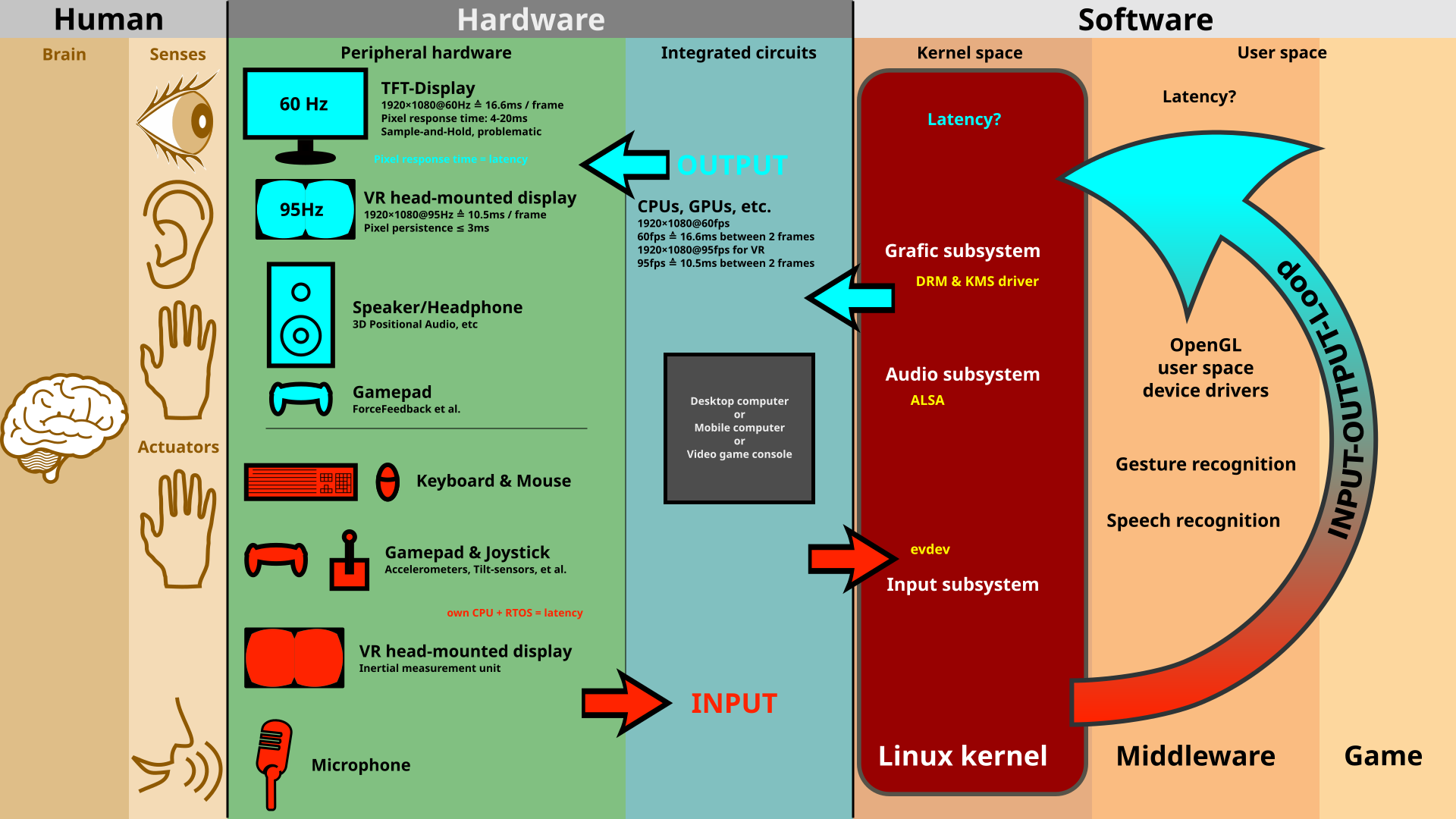 Paramount for the sensation of immersion into virtual reality are a high frame rate and low latency. Modern virtual reality headset displays are based on technology developed for smartphones including: gyroscopes and motion sensors for tracking head, body, and hand positions; small HD screens for stereoscopic displays; and small, lightweight and fast computer processors. These components led to relative affordability for independent VR developers, and led to the 2012 Oculus Rift Kickstarter offering the first independently developed VR headset.[58] Independent production of VR images and video has increased alongside the development of affordable omnidirectional cameras, also known as 360-degree cameras or VR cameras, that have the ability to record 360 interactive photography, although at relatively low resolutions or in highly compressed formats for online streaming of 360 video.[77] In contrast, photogrammetry is increasingly used to combine several high-resolution photographs for the creation of detailed 3D objects and environments in VR applications.[78][79] To create a feeling of immersion, special output devices are needed to display virtual worlds. Well-known formats include head-mounted displays or the CAVE. In order to convey a spatial impression, two images are generated and displayed from different perspectives (stereo projection). There are different technologies available to bring the respective image to the right eye. A distinction is made between active (e.g., shutter glasses) and passive technologies (e.g. polarizing filters or Infitec).[80] In order to improve the feeling of immersion, wearable multi-string cables offer haptics to complex geometries in virtual reality. These strings offer fine control of each finger joint to simulate the haptics involved in touching these virtual geometries.[81] Special input devices are required for interaction with the virtual world. Some of the most common input devices are motion controllers and optical tracking sensors. In some cases, wired gloves are used. Controllers typically use optical tracking systems (primarily infrared cameras) for location and navigation so that the user can move freely without wiring. Some input devices provide the user with force feedback to the hands or other parts of the body so that the user can orientate themselves in the three-dimensional world through haptics and sensor technology as a further sensory sensation and carry out realistic simulations. This allows the viewer to have a sense of direction in the artificial landscape. Additional haptic feedback can be obtained from omnidirectional treadmills (with which walking in virtual space is controlled by real walking movements) and vibration gloves and suits. Virtual reality cameras can be used to create VR photography using 360-degree panorama videos. VR cameras are available in various formats, with varying numbers of lenses installed in the camera.[82] Software The Virtual Reality Modelling Language (VRML), first introduced in 1994, was intended for the development of "virtual worlds" without dependency on headsets.[83] The Web3D consortium was subsequently founded in 1997 for the development of industry standards for web-based 3D graphics. The consortium subsequently developed X3D from the VRML framework as an archival, open-source standard for web-based distribution of VR content.[84] WebVR is an experimental JavaScript application programming interface (API) that provides support for various virtual reality devices, such as the HTC Vive, Oculus Rift, Google Cardboard or OSVR, in a web browser.[85] |
技術 関連項目:没入型技術 ハードウェア 関連項目:バーチャルリアリティヘッドセットの一覧  バーチャルリアリティへの没入感には、高いフレームレートと低遅延が不可欠です。 現代のバーチャルリアリティヘッドセットのディスプレイは、スマートフォン向けに開発された技術に基づいており、具体的には以下の要素が含まれる:頭部、 身体、手の位置を追跡するためのジャイロスコープとモーションセンサー;ステレオディスプレイ用の小型HDディスプレイ;小型、軽量、高速のコンピュータ プロセッサ。これらのコンポーネントは、独立系VR開発者にとっての相対的な手頃な価格を実現し、2012年のOculus RiftのKickstarterキャンペーンで、初めて独立開発されたVRヘッドセットが提供されるきっかけとなった。[58] VR画像やビデオの独立した制作は、360度カメラまたはVRカメラとしても知られる、手頃な価格の全方位カメラの開発とともに増加している。これらのカ メラは、360度のインタラクティブな写真を記録することができるが、解像度は比較的低く、360度ビデオをオンラインでストリーミングするために高度に 圧縮されたフォーマットで記録される。[77] 一方、フォトグラメトリは、VR アプリケーションで詳細な 3D オブジェクトや環境を作成するために、複数の高解像度写真を組み合わせるためにますます利用されている。[78][79] 没入感を生み出すためには、仮想世界を表現するための特別な出力デバイスが必要だ。よく知られているフォーマットとしては、ヘッドマウントディスプレイや CAVE がある。空間的な印象を伝えるためには、2 つの画像が異なる視点から生成され、表示される(ステレオ投影)。それぞれの画像を右目に届けるには、さまざまな技術がある。アクティブ技術(シャッター メガネなど)とパッシブ技術(偏光フィルターや Infitec など)が区別される。[80] 没入感を向上させるため、ウェアラブルマルチストリングケーブルは、バーチャルリアリティ内の複雑な形状に触覚を提供します。これらのストリングは、各指関節を細かく制御し、これらのバーチャル形状に触れたときの触覚をシミュレートします。[81] バーチャル世界との対話には、特別な入力デバイスが必要です。最も一般的な入力デバイスには、モーションコントローラや光学式トラッキングセンサーがあり ます。場合によっては、有線グローブも使用されます。コントローラーは通常、位置とナビゲーションのために光学追跡システム(主に赤外線カメラ)を使用 し、ユーザーが配線なしで自由に移動できるようにする。一部の入力デバイスは、ユーザーの手や体の他の部分に力フィードバックを提供し、ハプティクスとセ ンサー技術を通じて3次元世界での位置関係を認識し、現実的なシミュレーションを実行できるようにする。これにより、視聴者は人工的な風景内で方向感覚を 得ることができる。追加のハプティックフィードバックは、オムニディレクショナルトレッドミル(実際の歩行動作で仮想空間内の歩行を制御するもの)や振動 グローブ、スーツから得ることができる。 バーチャルリアリティカメラは、360度パノラマ動画を使用してVR写真を作成するために使用できる。VRカメラは、カメラに搭載されるレンズの数が異なるさまざまな形式で利用可能だ。[82] ソフトウェア 1994年に初めて導入されたバーチャルリアリティモデリング言語(VRML)は、ヘッドセットに依存しない「仮想世界」の開発を目的としていた。 [83] その後、1997年に、ウェブベースの3Dグラフィックスに関する業界標準の開発を目的としたWeb3Dコンソーシアムが設立された。同コンソーシアムは その後、VRMLフレームワークを基盤に、ウェブベースのVRコンテンツの配布用のアーカイブ可能なオープンソース標準としてX3Dを開発した。[84] WebVRは、ウェブブラウザ上でHTC Vive、Oculus Rift、Google Cardboard、OSVRなどのさまざまなVRデバイスをサポートする実験的なJavaScriptアプリケーションプログラミングインターフェース (API)だ。[85] |
| Visual immersion experience Display resolution Minimal Angle of Resolution (MAR) refers to the minimum distance between two display pixels. At a distance, a viewer can clearly distinguish the independent pixels. Often measured in arc-seconds, MAR between two pixels has to do with the viewing distance. For the general public, resolution is about 30–65 arc-seconds, which is referred to as the spatial resolution when combined with distance. Given the viewing distance of 1m and 2m respectively, regular viewers won't be able to perceive two pixels as separate if they are less than 0.29mm apart at 1m and less than 0.58mm apart at 2m.[86] Image latency and display refresh frequency Most small-size displays have a refresh rate of 60 Hz, which adds about 15ms of additional latency. The number is reduced to less than 7ms if the refresh rate is increased to 120 Hz or even 240 Hz and more.[87] Participants generally feel that the experience is more immersive with higher refresh rates as a result. However, higher refresh rates require a more powerful graphics processing unit. Relationship between display and field of view 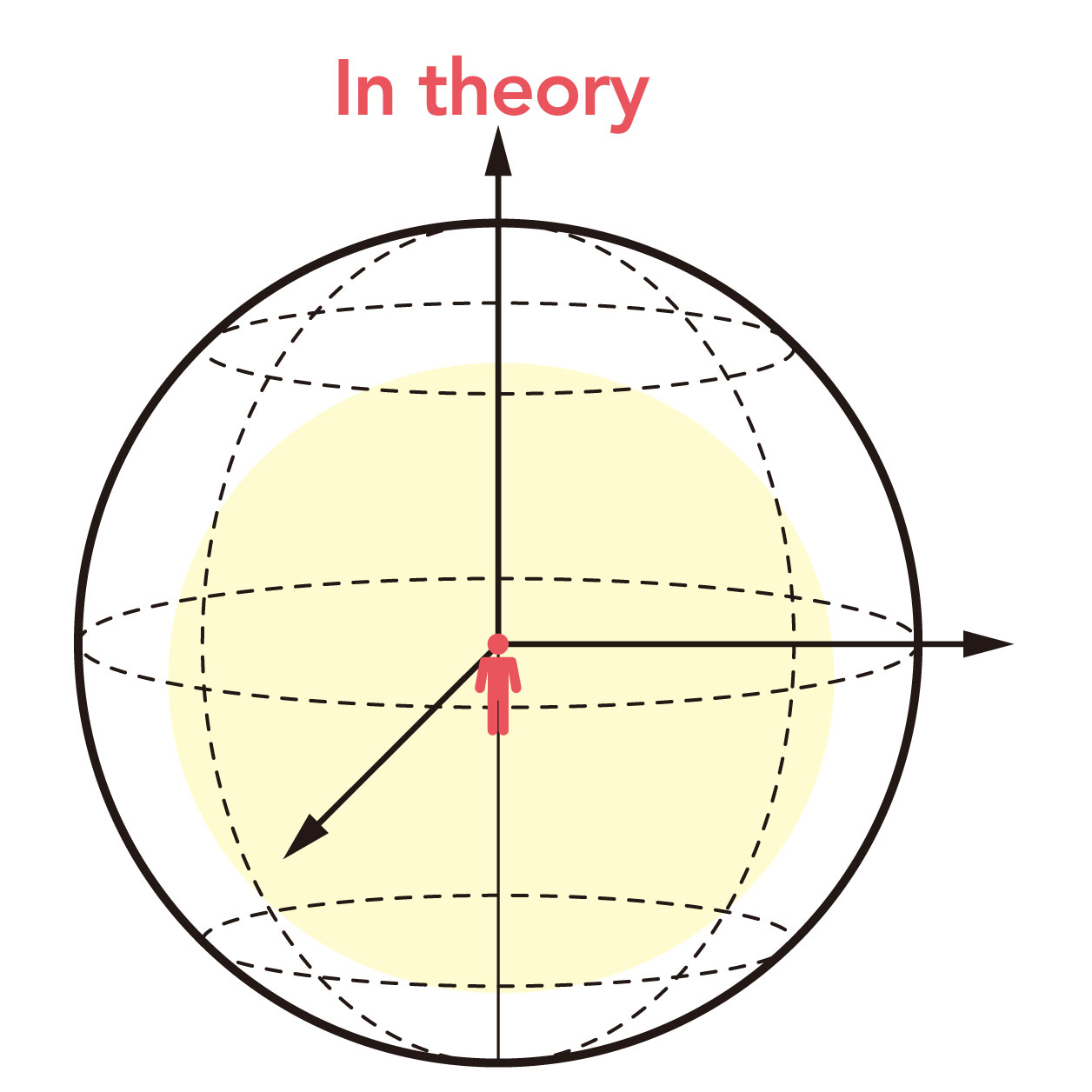 In theory, VR represents a participant's field of view (yellow area). In assessing the achieved immersion by a VR device, we need to consider our field of view (FOV) in addition to image quality. Our eyes have a horizontal FOV from about 107 or 110 degrees to the temporal side to about 60 or 70 degrees toward the nose and a vertical FOV from about 95 degrees downward to 85 degrees upward,[88] and eye movements are estimated as roughly 30 deg to either side horizontally and 20 vertically. Binocular vision is limited to the 120 or 140 degrees where the right and the left visual fields overlap. With eye movements, we have an FOV of roughly 300 degrees x 175 degrees with two eyes, i.e., approximately one third of the full 360-deg sphere. |
視覚的没入体験 ディスプレイ解像度 最小解像度角(MAR)とは、2つのディスプレイピクセル間の最小距離を指します。この距離から離れると、視聴者は独立したピクセルを明確に区別できなく なります。通常、秒角で測定され、2つのピクセル間のMARは視聴距離と関連しています。一般ユーザーの場合、解像度は約30~65秒角で、距離と組み合 わせた場合、空間解像度と呼ばれます。視聴距離がそれぞれ1mと2mの場合、通常の視聴者は、1mでは0.29mm未満、2mでは0.58mm未満の距離 にある2つのピクセルを別々のピクセルとして認識できない。[86] 画像遅延とディスプレイのリフレッシュレート 小型ディスプレイのほとんどは60Hzのリフレッシュレートを採用しており、これにより約15msの追加遅延が発生する。リフレッシュレートを120Hz または240Hz以上に増やすと、この数値は7ms未満に減少する。[87] 参加者は一般的に、リフレッシュレートが高いほど没入感が向上すると感じている。ただし、高いリフレッシュレートにはより高性能なグラフィックスプロセッ シングユニットが必要となる。 ディスプレイと視野の関係  理論上、VRは参加者の視野(黄色の領域)を表現する。 VRデバイスによる没入感を評価する際には、画像品質に加え、視野(FOV)を考慮する必要がある。人間の目は、水平方向の視野角が約107度または 110度から側頭部方向へ、約60度または70度鼻方向へ広がり、垂直方向の視野角は下方向約95度から上方向約85度まで広がっています。[88] 目の動きは、水平方向で約30度、垂直方向で約20度と推定されています。両眼視は、右と左の視界が重なる約120度または140度に制限されています。 眼球運動を考慮すると、両眼のFOVはおよそ300度×175度となり、つまり360度の球体の約1/3に相当します。 |
| Applications Main article: Virtual reality applications Virtual reality is most commonly used in entertainment applications such as video games, 3D cinema, amusement park rides including dark rides and social virtual worlds. Consumer virtual reality headsets were first released by video game companies in the early-mid 1990s. Beginning in the 2010s, next-generation commercial tethered headsets were released by Oculus (Rift), HTC (Vive) and Sony (PlayStation VR), setting off a new wave of application development.[89] 3D cinema has been used for sporting events, pornography, fine art, music videos and short films. Since 2015, roller coasters and theme parks have incorporated virtual reality to match visual effects with haptic feedback.[58] VR not only fits the trend of the digital industry but also enhances the film's visual effect. The film gives the audience more ways to interact through VR technology.[90] In social sciences and psychology, virtual reality offers a cost-effective tool to study and replicate interactions in a controlled environment.[91] It can be used as a form of therapeutic intervention.[92] For instance, there is the case of the virtual reality exposure therapy (VRET), a form of exposure therapy for treating anxiety disorders such as post traumatic stress disorder (PTSD) and phobias.[93][94][95] A VR therapy has been designed to help people with psychosis and agoraphobia manage their avoidance of outside environments. In the therapy, the user wears a headset and a virtual character provides psychological advice and guides them as they explore simulated environments (such as a cafe or a busy street). NICE is assessing the therapy to see if it should be recommended on the NHS.[96][97] During the COVID-19 pandemic, social VR has also been used as a mental-health tool in a form of self-administered, non-traditional cognitive behavioural therapy.[98] Virtual reality programs are being used in the rehabilitation processes with elderly individuals that have been diagnosed with Alzheimer's disease. This gives these elderly patients the opportunity to simulate real experiences that they would not otherwise be able to experience due to their current state. 17 recent studies with randomized controlled trials have shown that virtual reality applications are effective in treating cognitive deficits with neurological diagnoses.[99] Loss of mobility in elderly patients can lead to a sense of loneliness and depression. Virtual reality is able to assist in making aging in place a lifeline to an outside world that they cannot easily navigate. Virtual reality allows exposure therapy to take place in a safe environment.[100] In medicine, simulated VR surgical environments were first developed in the 1990s.[101][102][103] Under the supervision of experts, VR can provide effective and repeatable training[104] at a low cost, allowing trainees to recognize and amend errors as they occur.[105] Virtual reality has been used in physical rehabilitation since the 2000s. Despite numerous studies conducted, good quality evidence of its efficacy compared to other rehabilitation methods without sophisticated and expensive equipment is lacking for the treatment of Parkinson's disease.[106] A 2018 review on the effectiveness of mirror therapy by virtual reality and robotics for any type of pathology concluded in a similar way.[107] Another study was conducted that showed the potential for VR to promote mimicry and revealed the difference between non-autistic and autistic individuals in their response to a two-dimensional avatar.[108][109] Immersive virtual reality technology with myoelectric and motion tracking control may represent a possible therapy option for treatment-resistant phantom limb pain. Pain scale measurements were taken into account and an interactive 3-D kitchen environment was developed based on the principles of mirror therapy to allow for control of virtual hands while wearing a motion-tracked VR headset.[110] A systematic search in Pubmed and Embase was performed to determine results that were pooled in two meta-analysis. Meta-analysis showed a significant result in favor of VRT for balance.[111] In the fast-paced and globalised business world, meetings in VR are used to create an environment in which interactions with other people (e.g. colleagues, customers, partners) can feel more natural than a phone call or video chat. In the customisable meeting rooms all parties can join using the VR headset and interact as if they are in the same physical room. Presentations, videos or 3D models (of e.g. products or prototypes) can be uploaded and interacted with.[112] Compared to traditional text-based CMC, Avatar-based interactions in 3D virtual environment lead to higher levels of consensus, satisfaction, and cohesion among group members.[113] 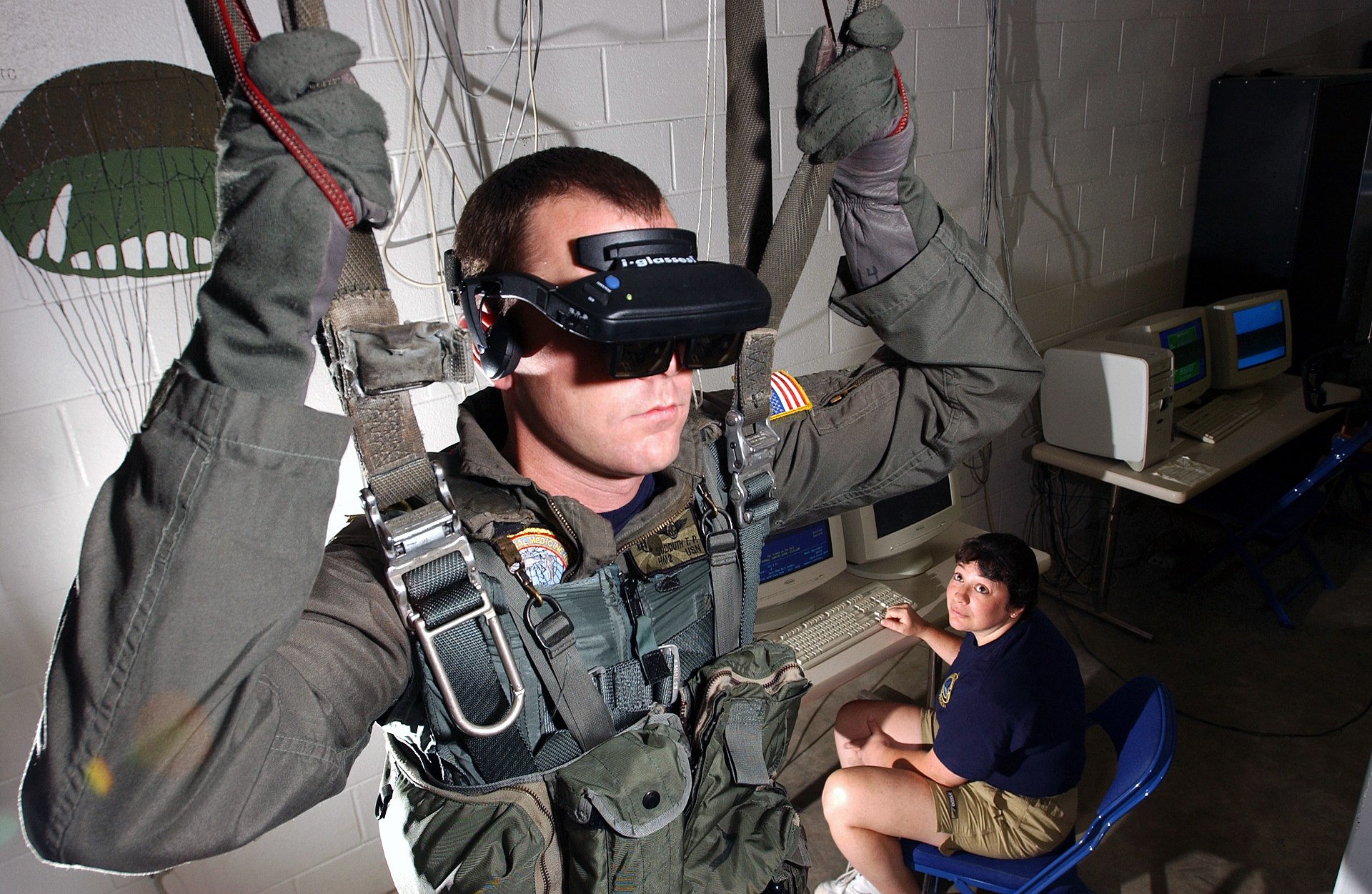 U.S. Navy Hospital Corpsman demonstrating a VR parachute simulator at the Naval Survival Training Institute in 2006 VR can simulate real workspaces for workplace occupational safety and health purposes, educational purposes, and training purposes. It can be used to provide learners with a virtual environment where they can develop their skills without the real-world consequences of failing. It has been used and studied in primary education,[114] anatomy teaching,[115][116] military,[117][118] astronaut training,[119][120][121] flight simulators,[122] mining and metallurgical operations training,[123][124] medical education,[125] geography education,[126] architectural design,[citation needed] driver training,[127] and bridge inspection.[128] Immersive VR engineering systems enable engineers to see virtual prototypes prior to the availability of any physical prototypes.[129] Supplementing training with virtual training environments has been claimed to offer avenues of realism in military[130] and healthcare[131] training while minimizing cost.[132] It also has been claimed to reduce military training costs by minimizing the amounts of ammunition expended during training periods.[130] VR can be used for the healthcare training and education for medical practitioners.[133][134] Further, several application have been developed for multiple types of safety training.[135][136] The latest results indicates that virtual reality safety training is more effective than traditional training in terms of knowledge acquisition and knowledge retention.[137] In the engineering field, VR has proved very useful for both engineering educators and the students. A previously expensive cost in the educational department now being much more accessible due to lowered overall costs, has proven to be a very useful tool in educating future engineers. The most significant element lies in the ability for the students to be able to interact with 3-D models that accurately respond based on real world possibilities. This added tool of education provides many the immersion needed to grasp complex topics and be able to apply them.[138] As noted, the future architects and engineers benefit greatly by being able to form understandings between spatial relationships and providing solutions based on real-world future applications.[139] The first fine art virtual world was created in the 1970s.[140] As the technology developed, more artistic programs were produced throughout the 1990s, including feature films. When commercially available technology became more widespread, VR festivals began to emerge in the mid-2010s. The first uses of VR in museum settings began in the 1990s, seeing a significant increase in the mid-2010s. Additionally, museums have begun making some of their content virtual reality accessible.[141][142] Virtual reality's growing market presents an opportunity and an alternative channel for digital marketing.[143] It is also seen as a new platform for e-commerce, particularly in the bid to challenge traditional "brick and mortar" retailers. However, a 2018 study revealed that the majority of goods are still purchased in physical stores.[144] In the case of education, the uses of virtual reality have demonstrated being capable of promoting higher order thinking,[145] promoting the interest and commitment of students, the acquisition of knowledge, promoting mental habits and understanding that are generally useful within an academic context.[146] A case has also been made for including virtual reality technology in the context of public libraries. This would give library users access to cutting-edge technology and unique educational experiences.[147] This could include giving users access to virtual, interactive copies of rare texts and artifacts and to tours of famous landmarks and archeological digs (as in the case with the Virtual Ganjali Khan Project).[148] Starting in the early 2020s, virtual reality has also been discussed as a technological setting that may support people's grieving process, based on digital recreations of deceased individuals. In 2021, this practice received substantial media attention following a South Korean TV documentary, which invited a grieving mother to interact with a virtual replica of her deceased daughter.[149] Subsequently, scientists have summarized several potential implications of such endeavours, including its potential to facilitate adaptive mourning, but also many ethical challenges.[150][151] Growing interest in the metaverse has resulted in organizational efforts to incorporate the many diverse applications of virtual reality into ecosystems like VIVERSE, reportedly offering connectivity between platforms for a wide range of uses.[152] |
アプリケーション 主な記事:バーチャルリアリティアプリケーション バーチャルリアリティは、ビデオゲーム、3Dシネマ、ダークライドなどの遊園地のアトラクション、ソーシャルバーチャルワールドなどのエンターテイメント アプリケーションで最もよく使用されている。消費者向けバーチャルリアリティヘッドセットは、1990年代前半から半ばにかけて、ビデオゲーム会社によっ て初めて発売された。2010年代以降、Oculus(Rift)、HTC(Vive)、ソニー(PlayStation VR)が次世代の商用有線ヘッドセットを発売し、新たなアプリケーション開発の波を引き起こした。[89] 3Dシネマは、スポーツイベント、ポルノ、美術、ミュージックビデオ、短編映画などに利用されている。2015年以降、ローラーコースターやテーマパーク では、視覚効果と触覚フィードバックを組み合わせたバーチャルリアリティが採用されている。[58] VRはデジタル産業のトレンドに適合するだけでなく、映画の視覚効果を強化する。映画はVR技術を通じて観客がより多くの方法でインタラクションできる機 会を提供する。[90] 社会科学や心理学の分野では、バーチャルリアリティは、制御された環境下で相互作用を研究・再現するための費用対効果の高いツールとして活用されている [91]。また、治療的介入の一形態としても活用できる[92]。例えば、心的外傷後ストレス障害(PTSD)や恐怖症などの不安障害の治療のための暴露 療法の一形態であるバーチャルリアリティ暴露療法(VRET)がある[93][94]。[95] VR 療法は、精神病や広場恐怖症の人々が外部環境からの回避を管理するのを支援するために設計された。この療法では、ユーザーはヘッドセットを装着し、仮想 キャラクターが心理的なアドバイスを提供し、シミュレーションされた環境(カフェやにぎやかな通りなど)を探索するユーザーをガイドする。NICE は、この療法を NHS で推奨すべきかどうか評価している。[96][97] COVID-19 のパンデミックの間、ソーシャル VR は、自己管理型の非伝統的な認知行動療法の一形態として、メンタルヘルスのツールとしても活用されている。[98] バーチャルリアリティプログラムは、アルツハイマー病と診断された高齢 者のリハビリテーションプロセスにも活用されている。これにより、これらの高齢患者は、現在の状態では体験できない現実の経験をシミュレートする機会を得 ることができます。17件のランダム化比較試験を含む最近の研究では、バーチャルリアリティアプリケーションが神経疾患による認知機能障害の治療に有効で あることが示されています。[99] 高齢患者の移動能力の低下は、孤独感や抑うつを引き起こす可能性があります。バーチャルリアリティは、高齢者が自宅での生活を継続するためのライフライン として、容易にアクセスできない外部世界への接続を支援することができます。バーチャルリアリティは、安全な環境で曝露療法を実施することを可能にする。 [100] 医療分野では、バーチャルリアリティを用いた手術環境のシミュレーションが1990年代に初めて開発された。[101][102][103] 専門家の監督の下、バーチャルリアリティは、低コストで効果的で再現性の高いトレーニング[104] を提供し、研修生がエラーを認識し、発生時に修正することを可能にする。[105] バーチャルリアリティは、2000年代から身体のリハビリテーションにも利用されている。数多くの研究が行われているにもかかわらず、高度で高価な機器を 使用しない他のリハビリテーション方法と比較した、パーキンソン病の治療におけるその有効性に関する質の高い証拠は不足している。[106] 2018年に、あらゆる種類の病状に対するバーチャルリアリティとロボット工学によるミラー療法の有効性について行われたレビューでも、同様の結論が導か れている。[107] 別の研究では、VR が模倣を促進する可能性があることが示され、2 次元アバターに対する自閉症者と非自閉症者の反応の違いが明らかになった。[108][109] 筋電およびモーショントラッキング制御を備えた没入型バーチャルリアリティ技術は、治療抵抗性の幻肢痛の治療法として可能性を秘めている。痛みの尺度測定 値を考慮し、ミラー療法の原理に基づいて、モーショントラッキング VR ヘッドセットを装着しながら仮想の手を操作できるインタラクティブな 3D キッチン環境を開発した。[110] Pubmed および Embase で系統的な検索を行い、2 件のメタ分析で結果を統合した。メタ分析では、バランスに関しては VRT が有意に有効であることが示された。[111] ペースの速いグローバル化したビジネスの世界では、VR による会議は、電話やビデオチャットよりも、他の人々(同僚、顧客、パートナーなど)とのやり取りがより自然に行える環境を作るために利用されている。カ スタマイズ可能な会議室では、すべての参加者が VR ヘッドセットを使用して参加し、まるで同じ物理的な部屋にいるかのように交流することができる。プレゼンテーション、動画、または3Dモデル(例:製品や プロトタイプ)をアップロードし、インタラクションが可能です。[112] 伝統的なテキストベースのCMCと比較して、3D仮想環境におけるアバターベースのインタラクションは、グループメンバー間の合意、満足度、結束のレベル を向上させます。[113]  2006年に海軍生存訓練研究所でVRパラシュートシミュレーターをデモする米海軍病院兵 VR は、職場の安全衛生、教育、研修の目的で、実際の職場をシミュレートすることができる。学習者に、失敗による現実世界での影響を受けることなく、スキルを 磨くことができる仮想環境を提供するために利用することができる。VR は、初等教育[114]、解剖学教育[115][116]、軍事[117][118]、宇宙飛行士訓練[119]、[120][121]、飛行シミュレー ター[122]、鉱山・金属加工作業訓練[123][124]、医療教育[125]、地理教育[126]、建築設計[出典必要]、ドライバー訓練 [127]、橋梁検査[128]など多岐にわたる分野で活用されています。没入型VRエンジニアリングシステムは、物理的なプロトタイプが存在する前に、 エンジニアが仮想プロトタイプを確認することを可能にします。[129] 仮想訓練環境を訓練に補完的に活用することは、軍事[130] および医療[131] 訓練において現実感を高めつつコストを最小限に抑える手段として主張されている。[132] また、訓練期間中に消費される弾薬の量を最小限に抑えることで、軍事訓練のコストを削減できると主張されている。[130] VRは、医療従事者の医療訓練および教育にも活用できる。[133][134] さらに、複数の種類の安全訓練向けに複数のアプリケーションが開発されている。[135][136] 最新の結果は、バーチャルリアリティ安全訓練が、知識の習得と保持の面で伝統的な訓練よりも効果的であることを示している。[137] 工学分野では、VRは工学教育者および学生の両方にとって非常に有用であることが証明されている。教育部門で以前高額だったコストが、全体的なコストの低 下により大幅にアクセスしやすくなったため、将来のエンジニアを教育する上で非常に有用なツールとなっている。最も重要な要素は、学生が現実の世界の可能 性に基づいて正確に反応する3Dモデルと相互作用できる点にある。この追加の教育ツールは、複雑なトピックを理解し、それを応用するために必要な没入感を 提供している。[138] 前述のように、将来の建築家やエンジニアは、空間的な関係を理解し、現実世界の将来的な応用に基づいて解決策を提案できることで、大きな恩恵を受けてい る。[139] 最初のファインアートの仮想世界は 1970 年代に作成された。[140] 技術の発展に伴い、1990年代にはより多くの芸術的なプログラムが制作され、長編映画も含まれるようになった。商業用技術が広く普及するにつれ、 2010年代半ばからVRフェスティバルが台頭し始めた。博物館でのVRの最初の利用は1990年代に始まり、2010年代半ばに大幅な増加が見られた。 さらに、博物館は一部のコンテンツをバーチャルリアリティでアクセス可能にする取り組みを開始している。[141][142] バーチャルリアリティの市場拡大は、デジタルマーケティングにとってチャンスであり、新たなチャネルでもあります。[143] また、特に従来の「実店舗」型小売業に挑む、e コマースの新しいプラットフォームとしても注目されています。しかし、2018 年の調査によると、商品の大部分は依然として実店舗で購入されています。[144] 教育分野では、バーチャルリアリティの利用は、高次思考の促進[145]、学生の興味と意欲の向上、知識の習得、学術的な文脈で一般的に有用な思考習慣と理解の促進に有効であることが示されている。 公共図書館の文脈においてバーチャルリアリティ技術を導入する提案もされています。これにより、図書館利用者は最先端技術と独自の教育体験にアクセスでき るようになります。[147] これには、希少なテキストや遺物のバーチャルなインタラクティブ版へのアクセスや、著名なランドマークや考古学発掘現場のツアー(バーチャル・ガンジャ リ・カーン・プロジェクトの例のように)が含まれる可能性があります。[148] 2020 年代初頭から、バーチャルリアリティは、故人をデジタルで再現することで、人々の悲嘆の過程を支援する技術的環境としても議論されている。2021 年、韓国のテレビドキュメンタリー番組で、悲嘆に暮れる母親が、亡くなった娘のバーチャルレプリカと交流する様子が紹介され、この取り組みはメディアで大 きな注目を集めた。[149] その後、科学者たちは、このような取り組みのいくつかの潜在的な影響、例えば適応的な悲嘆の促進の可能性、しかし同時に多くの倫理的課題も指摘している。 [150][151] メタバースへの関心の高まりを受けて、バーチャルリアリティの多様な応用を VIVERSE などのエコシステムに組み込む組織的な取り組みが進んでおり、幅広い用途のためのプラットフォーム間の接続性を提供すると報じられている。[152] |
| Medical uses of VR Virtual reality (VR) technology has emerged as a significant tool in medical training and education. Specifically, there has been a major leap in innovation in surgical simulation and surgical real-time enhancement.[153] Studies done at North Carolina medical institutions have demonstrated improvement in technical performance and skills among medical students and active surgeons using VR training as compared to traditional training, especially in procedures such as total hip arthroplasty.[153] Alongside this, other VR simulation programs such as LapSim, improve basic coordination, instrument handling, and procedure-based skills.[154] These simulations aim to have high ratings for feedback and haptic touch, which provides a more realistic surgical feel. Studies show significant improvement in task completion time and scores after 4-week training sessions of LapSim. This simulation environment also allows surgeons to practice without risk to real patients, promoting patient safety.[154] Based on data from research conducted from the University Hospitals Schleswig-Holstein and collaborators from other institutions, medical students and surgeons with years of experience, show marked performance boosts after practicing with LapSim VR technology.[154] Another recent study at North Carolina University of Chapel Hill has shown that developing VR and Augmented Reality (AR) systems have allowed surgeons to keep their eyes on a patient while accessing CT scans. This VR system allows for laparoscopic imaging integration, real-time skin layer visualization, and enhanced surgical precision capabilities.[153] These are both examples of how studies have shown surgeons can take advantage of additional virtual reality simulation practices, which can create incredible experiences, provide customized scenarios, and provide independent learning with haptic feedback.[154] These VR systems need to be realistic enough for education tools alongside being able to measure performance of a surgeon. Some potential future challenges of this technology would be enhancing complex scenarios alongside the realism aspects. These technologies would need to incorporate stress-inducing factors along with other realistic simulation ideas.[154] Furthermore, there would be a need to have better AR integration to help the surgeon have better eyes-on precision guidance. Lastly, there would be a strong need to keep things cost-effective with an abundance of availability. |
VR の医療用途 バーチャルリアリティ(VR)技術は、医療の訓練や教育において重要なツールとして登場しています。特に、外科手術のシミュレーションやリアルタイムの手 術支援において、大きな飛躍的な進歩が見られます[153]。ノースカロライナ州の医療機関で行われた研究では、VR トレーニングを受けた医学生や現役の外科医は、従来のトレーニングを受けた者よりも、特に人工股関節全置換術などの手術において、技術的なパフォーマンス と技能が向上したことが実証されています[153]。これと並行して、LapSimなどの他のVRシミュレーションプログラムは、基本的な協調性、器具の 取り扱い、手技に基づくスキルを向上させています。[154] これらのシミュレーションは、フィードバックと触覚の精度が高く、より現実的な手術の感覚を提供することを目的としています。 研究によると、LapSimの4週間のトレーニングセッション後、タスク完了時間とスコアに著しい改善が見られました。このシミュレーション環境は、外科医が実際の患者にリスクを及ぼすことなく練習できるため、患者安全の向上にも寄与しています。[154] シュレスヴィヒ・ホルシュタイン大学病院および他の機関の研究データによると、医学生や長年の経験を持つ外科医は、LapSim VR テクノロジーを使用して練習を行った後、パフォーマンスが大幅に向上しています。[154] ノースカロライナ大学チャペルヒル校での最近の別の研究では、VR および拡張現実 (AR) システムの開発により、外科医は CT スキャンにアクセスしながら患者から目を離す必要がなくなったことが示されています。この VR システムにより、腹腔鏡画像統合、リアルタイムの皮膚層の視覚化、および手術の精度向上が可能になった。[153] これらは、外科医が追加のバーチャルリアリティシミュレーション実習を活用することで、素晴らしい体験を生み出し、カスタマイズされたシナリオを提供し、 触覚フィードバックによる自主的な学習を実現できることを示した研究例だ。[154] これらの VR システムは、外科医のパフォーマンスを測定できるだけでなく、教育ツールとして十分なリアリティを備えている必要がある。 この技術の将来的な課題としては、現実感の向上と複雑なシナリオの強化が挙げられる。これらの技術は、ストレス誘発要因や他の現実的なシミュレーションア イデアを組み込む必要がある。[154] さらに、外科医の視線精度を向上させるためのAR統合の改善も必要となる。最後に、コスト効果を維持しつつ、十分な可用性を確保することが強く求められ る。 |
| Concerts In June of 2020, Jean Michel Jarre performed in VRChat.[155] In July, Brendan Bradley released the free FutureStages web-based virtual reality venue for live events and concerts throughout the 2020 shutdown,[156] Justin Bieber performed on November 18, 2021 in WaveXR.[157] On December 2, 2021, non-player characters performed at the Mugar Omni Theater with audiences interacting with a live performer in both virtual reality and projected on the IMAX dome screen.[158][159] Meta's Foo Fighters Super Bowl VR concert performed on Venues.[160] Post Malone performed in Venues starting July 15, 2022.[161] Megan Thee Stallion performed on AMAZE at AMC Theaters throughout 2022.[162] On October 24, 2021, Billie Eilish performed on Oculus Venues. Pop group Imagine Dragons performed on June 15, 2022. |
コンサート 2020年6月、ジャン・ミシェル・ジャールがVRChatで公演を行った[155]。7月、ブレンダン・ブラッドリーは、2020年の閉鎖期間中、ライ ブイベントやコンサートのための無料のウェブベースのバーチャルリアリティ会場「FutureStages」を公開した[156]。ジャスティン・ビー バーは、2021年11月18日にWaveXRで公演を行った。[157] 2021年12月2日、Mugar Omni Theater で、非プレイヤーキャラクターが、バーチャルリアリティと IMAX ドームスクリーンに映し出されたライブパフォーマーと観客が交流しながらパフォーマンスを行った。[158][159] Meta の Foo Fighters Super Bowl VR コンサートが Venues で開催された。[160] ポスト・マローンは、2022年7月15日より Venues でパフォーマンスを行う。[161] ミーガン・ティー・スタリオンは、2022年を通して AMC シアターズの AMAZE で公演を行う。[162] 2021年10月24日、ビリー・アイリッシュが Oculus Venues で公演を行った。ポップグループ、イマジン・ドラゴンズは2022年6月15日に公演を行う。 |
| Concerns and challenges Health and safety There are many health and safety considerations of virtual reality. A number of unwanted symptoms have been caused by prolonged use of virtual reality,[163] and these may have slowed the proliferation of the technology. Most virtual reality systems come with consumer warnings, including seizures; developmental issues in children; trip-and-fall and collision warnings; discomfort; repetitive stress injury; and interference with medical devices.[164] Some users may experience twitches, seizures, or blackouts while using VR headsets, even if they do not have a history of epilepsy and have never had blackouts or seizures before. One in 4,000 people, or .025%, may experience these symptoms. Motion sickness, eyestrain, headaches, and discomfort are the most prevalent short-term adverse effects. In addition, because of the virtual reality headsets' heavy weight, discomfort may be more likely among children. Therefore, children are advised against using VR headsets.[165] Other problems may occur in physical interactions with one's environment. While wearing VR headsets, people quickly lose awareness of their real-world surroundings and may injure themselves by tripping over or colliding with real-world objects.[166] VR headsets may regularly cause eye fatigue, as does all screened technology, because people tend to blink less when watching screens, causing their eyes to become more dried out.[167] There have been some concerns about VR headsets contributing to myopia, but although VR headsets sit close to the eyes, they may not necessarily contribute to nearsightedness if the focal length of the image being displayed is sufficiently far away.[168] Virtual reality sickness (also known as cybersickness) occurs when a person's exposure to a virtual environment causes symptoms that are similar to motion sickness symptoms.[169] Women are significantly more affected than men by headset-induced symptoms, at rates of around 77% and 33% respectively.[170][171] The most common symptoms are general discomfort, headache, stomach awareness, nausea, vomiting, pallor, sweating, fatigue, drowsiness, disorientation, and apathy.[172] For example, Nintendo's Virtual Boy received much criticism for its negative physical effects, including "dizziness, nausea, and headaches".[173] These motion sickness symptoms are caused by a disconnect between what is being seen and what the rest of the body perceives. When the vestibular system, the body's internal balancing system, does not experience the motion that it expects from visual input through the eyes, the user may experience VR sickness. This can also happen if the VR system does not have a high enough frame rate, or if there is a lag between the body's movement and the onscreen visual reaction to it.[174] Because approximately 25–40% of people experience some kind of VR sickness when using VR machines, companies are actively looking for ways to reduce VR sickness.[175] Vergence-accommodation conflict (VAC) is one of the main causes of virtual reality sickness.[176] In January 2022 The Wall Street Journal found that VR usage could lead to physical injuries including leg, hand, arm and shoulder injuries.[177] VR usage has also been tied to incidents that resulted in neck injuries (especially injures to the cervical vertebrae).[178] |
懸念事項と課題 健康と安全 バーチャルリアリティには、健康と安全に関する多くの考慮事項がある。バーチャルリアリティの長期使用により、多くの望ましくない症状が発生しており [163]、これがこの技術の普及を遅らせている可能性がある。ほとんどのバーチャルリアリティシステムには、発作、子供の発達障害、つまずきや転倒、衝 突に関する警告、不快感、反復ストレス障害、医療機器への干渉など、消費者向けの警告が記載されている。[164] 一部のユーザーは、てんかんの病歴がなく、これまで失神や発作を経験したことがない場合でも、VR ヘッドセットの使用中にけいれん、発作、失神を経験する場合がある。4,000 人に 1 人、つまり 0.025% の人がこれらの症状を経験する可能性がある。乗り物酔い、眼精疲労、頭痛、不快感などが、最も一般的な短期的な副作用だ。さらに、バーチャルリアリティ ヘッドセットは重量があるため、子供たちは不快感を感じやすい傾向がある。そのため、子供たちは VR ヘッドセットの使用を控えるよう勧められている。[165] 自分の環境との物理的な相互作用において、その他の問題も発生する可能性がある。VR ヘッドセットを装着していると、人々は現実世界の周囲の状況に対する認識をすぐに失い、現実世界の物につまずいたり、ぶつかったりして怪我をする可能性が ある。[166] VR ヘッドセットは、他のスクリーン技術と同様、画面を見ている間はまばたきの回数が少なくなるため、目が乾燥し、眼精疲労を引き起こすことが多い。 [167] VR ヘッドセットが近視の原因となるのではないかという懸念もあるが、VR ヘッドセットは目に近い位置に装着されるものの、表示される画像の焦点距離が十分に遠い場合は、必ずしも近視の原因になるとは限らない。[168] バーチャルリアリティ酔い(サイバースickness とも呼ばれる)は、人が仮想環境にさらされることで、乗り物酔いの症状に似た症状が現れる現象だ。[169] ヘッドセットによる症状は、女性の方が男性よりも著しく多く、その割合はそれぞれ約 77% と 33% だ。[170][171] 最も一般的な症状は、一般的な不快感、頭痛、胃の意識、吐き気、嘔吐、顔面蒼白、発汗、疲労、眠気、方向感覚の喪失、無関心などです。[172] 例えば、任天堂のバーチャルボーイは、「めまい、吐き気、頭痛」などの負の物理的影響で多くの批判を受けました。[173] これらの動揺病症状は、視覚情報と身体の他の部分で認識される情報との不一致によって引き起こされる。内耳の平衡器官である前庭系が、目から得られる視覚 情報から予想される運動を認識できない場合、ユーザーはVR病を経験する可能性がある。これは、VR システムのフレームレートが十分に高くない場合や、身体の動きと画面上の視覚的反応との間に遅延がある場合にも発生する。[174] VR 機器を使用すると、約 25~40% の人々が何らかの VR 酔いを経験するため、企業は VR 酔いを軽減する方法を積極的に模索している。[175] 輻輳調節不調和(VAC)は、VR酔いの主な原因の一つだ。[176] 2022年1月、ウォールストリート・ジャーナルは、VRの使用が脚、手、腕、肩の怪我を含む身体的怪我を引き起こす可能性があると報告した。[177] VRの使用は、首の怪我(特に頚椎の怪我)を引き起こす事故とも関連している。[178] |
| Children and teenagers in virtual reality Children are becoming increasingly aware of VR, with the number in the USA having never heard of it dropping by half from Autumn 2016 (40%) to Spring 2017 (19%).[179] A 2022 research report by Piper Sandler revealed that only 26% of U.S. teens own a VR device, 5% use it daily, while 48% of teen headset owners "seldom" use it. Of the teens who don't own a VR headset, 9% plan to buy one. 50% of surveyed teens are unsure about the metaverse or don't have any interest, and don't have any plans to purchase a VR headset.[180] Studies show that young children, compared to adults, may respond cognitively and behaviorally to immersive VR in ways that differ from adults. VR places users directly into the media content, potentially making the experience very vivid and real for children. For example, children of 6–18 years of age reported higher levels of presence and "realness" of a virtual environment compared with adults 19–65 years of age.[181] Studies on VR consumer behavior or its effect on children and a code of ethical conduct involving underage users are especially needed, given the availability of VR porn and violent content. Related research on violence in video games suggests that exposure to media violence may affect attitudes, behavior, and even self-concept. Self-concept is a key indicator of core attitudes and coping abilities, particularly in adolescents.[182] Early studies conducted on observing versus participating in violent VR games suggest that physiological arousal and aggressive thoughts, but not hostile feelings, are higher for participants than for observers of the virtual reality game.[183] Experiencing VR by children may further involve simultaneously holding the idea of the virtual world in mind while experiencing the physical world. Excessive usage of immersive technology that has very salient sensory features may compromise children's ability to maintain the rules of the physical world, particularly when wearing a VR headset that blocks out the location of objects in the physical world. Immersive VR can provide users with multisensory experiences that replicate reality or create scenarios that are impossible or dangerous in the physical world. Observations of 10 children experiencing VR for the first time suggested that 8-12-years-old kids were more confident to explore VR content when it was in a familiar situation, e.g. the children enjoyed playing in the kitchen context of Job Simulator, and enjoyed breaking rules by engaging in activities they are not allowed to do in reality, such as setting things on fire.[179] |
バーチャルリアリティにおける子どもとティーンエイジャー 子どもたちは VR に対する認識を高めており、米国では VR を聞いたことがないという割合が 2016 年秋(40%)から 2017 年春(19%)にかけて半減した。[179] Piper Sandler の 2022 年の調査報告書によると、米国のティーンエイジャーのうち VR デバイスを所有しているのは 26% に過ぎず、毎日使用しているのは 5% で、ヘッドセットを所有しているティーンエイジャーの 48% は「ほとんど使用しない」と答えている。VRヘッドセットを所有していないティーンのうち、9%が購入を検討している。調査対象のティーンのうち50%は メタバースについて不明確な認識を持っていたり興味がなかったりし、VRヘッドセットの購入計画もない。[180] 研究によると、幼児は大人に比べて、没入型の VR に対して認知的および行動的に大人とは異なる反応を示す可能性があることが示されています。VR はユーザーをメディアコンテンツの中に直接入り込ませるため、子供たちにとっては非常に鮮明でリアルな体験となる可能性があります。例えば、6歳から18 歳の子供たちは、19歳から65歳の大人に比べて、仮想環境の「存在感」や「現実感」が高いと報告しています。[181] VRポルノや暴力的なコンテンツが利用可能になっていることを考えると、VRの消費者行動や子供たちへの影響に関する研究、および未成年ユーザーに関する 倫理行動規範が特に必要とされている。ビデオゲームにおける暴力に関する関連研究では、メディアの暴力にさらされると、態度、行動、さらには自己概念にも 影響を与える可能性があることが示唆されている。自己概念は、特に青少年の基本的な態度や対処能力の重要な指標です。[182] 暴力的な VR ゲームを観察することと参加することについて実施された初期の研究では、仮想現実ゲームの参加者の方が、観察者よりも生理的興奮や攻撃的な思考は高いが、 敵意は強くないことが示唆されています。[183] 子供たちが VR を体験する場合、現実の世界を体験しながら、仮想世界の概念を同時に頭の中に保持することもあるでしょう。非常に顕著な感覚的特徴を持つ没入型技術を過度 に使用すると、特に物理的な世界の物体の位置を見えなくする VR ヘッドセットを装着している場合、子供たちが物理的な世界のルールを維持する能力が損なわれるおそれがある。没入型 VR は、現実を再現したり、物理的な世界では不可能または危険なシナリオを作成したりする、多感覚体験をユーザーに提供することができる。VRを初めて体験し た10人の子どもを観察した結果、8~12歳の子どもは、馴染みのある状況下でVRコンテンツを閲覧する際により自信を持って探索する傾向が見られた。例 えば、子どもたちは『Job Simulator』のキッチン設定で遊ぶことを楽しんだほか、現実では禁止されている行為(物を燃やすなど)を行うことでルールを破ることを楽しんだ。 [179] |
| Privacy Digital privacy concerns have been associated with VR platforms;[184][185] the persistent tracking required by all VR systems makes the technology particularly useful for, and vulnerable to, mass surveillance, including information gathering of personal actions, movements and responses.[58] Data from eye tracking sensors, which are projected to become a standard feature in virtual reality headsets,[186][187] may indirectly reveal information about a user's ethnicity, personality traits, fears, emotions, interests, skills, and physical and mental health conditions.[188] The nature of VR technology means that it can gather a wide range of data about its users. This can include obvious information such as usernames and account information, but also extends to more personal data like physical movements, interaction habits, and responses to virtual environments. In addition, advanced VR systems can capture biometric data like voice patterns, eye movements, and physiological responses to VR experiences.[189][190] Virtual reality technology has grown substantially since its inception, moving from a niche technology to a mainstream consumer product. As the user base has grown, so too has the amount of personal data collected by these systems.[191] This data can be used to improve VR systems, to provide personalized experiences, or to collect demographic information for marketing purposes. However, it also raises significant privacy concerns, especially when this data is stored, shared, or sold without the user's explicit consent.[192] Existing data protection and privacy laws like the General Data Protection Regulation (GDPR) in the EU, and the California Consumer Privacy Act (CCPA) in the United States, can be applied to VR. These regulations require companies to disclose how they collect and use data, and give users a degree of control over their personal information.[193] Despite these regulations, enforcing privacy laws in VR can be challenging due to the global nature of the technology and the vast amounts of data collected.[194] Due to its history of privacy issues, the involvement of Meta Platforms (formerly Facebook, Inc.) in the VR market has led to privacy concerns specific to its platforms. In August 2020, Facebook announced that Oculus products would become subject to the terms of use and privacy policy of the Facebook social network, and that a Facebook account would be required to use future Oculus headset models, and all existing models (via deprecation of the separate Oculus account system) beginning January 2023. The announcement was criticized for the mandatory integration of Oculus headsets with Facebook data collection and policies (including the Facebook real-name policy), and preventing use of the hardware if the user's account is suspended.[195][196] The following month, Facebook halted the sale of Oculus products in Germany due to concerns from regulators that the new policy was a violation of GDPR.[197] In 2022, the company would later establish a separate "Meta account" system.[198] In 2024, researchers from the University of Chicago demonstrated a security vulnerability in Meta Quest's Android-based system software (leveraging "Developer Mode" to inject an infected app), allowing them to obtain users' login credentials and inject false details during online banking sessions. This attack was considered to be difficult to execute outside of research settings but would make its target vulnerable to risks such as phishing, Internet fraud, and grooming.[199] |
プライバシー デジタルプライバシーの懸念は、VR プラットフォームと関連付けられている[184][185]。すべての VR システムで必要な持続的な追跡により、この技術は、個人の行動、動き、反応などの情報収集を含む、大量監視に特に有用であると同時に、その対象となりやす い。[58] バーチャルリアリティヘッドセットの標準機能となることが予想される視線追跡センサーからのデータ[186][187] は、ユーザーの民族、性格、恐怖心、感情、興味、スキル、および心身の健康状態に関する情報を間接的に明らかにする可能性がある。[188] VR 技術の性質上、ユーザーに関する幅広いデータを収集することができます。これには、ユーザー名やアカウント情報などの明らかな情報だけでなく、身体の動 き、相互作用の習慣、仮想環境への反応などのより個人的なデータも含まれます。さらに、高度な VR システムでは、音声パターン、眼球運動、VR 体験に対する生理的反応などの生体認証データを取得することもできます。[189][190] バーチャルリアリティ技術は、その誕生以来、ニッチな技術から主流の消費者向け製品へと大きく成長した。ユーザーベースが拡大するにつれて、これらのシス テムによって収集される個人データの量も増加している。[191] このデータは、VR システムの改善、パーソナライズされた体験の提供、マーケティング目的の人口統計情報の収集などに利用することができる。しかし、特にこのデータがユー ザーの明示的な同意なしに保存、共有、販売される場合、プライバシーに関する重大な懸念が生じる。[192] EU の一般データ保護規則(GDPR)や米国のカリフォルニア州消費者プライバシー法(CCPA)などの既存のデータ保護およびプライバシーに関する法律は、 VR にも適用されます。これらの規制は、企業にデータの収集および使用方法を開示し、ユーザーに自分の個人情報について一定の管理権を与えることを義務付けて います。[193] これらの規制にもかかわらず、VR におけるプライバシー法の施行は、この技術のグローバルな性質と収集されるデータ量の多さから、困難な課題となっている。[194] プライバシー問題の歴史から、Meta Platforms(旧 Facebook, Inc.)の VR 市場への参入は、同社のプラットフォーム特有のプライバシーに関する懸念を引き起こしている。2020年8月、Facebook は、Oculus 製品が Facebook ソーシャルネットワークの利用規約およびプライバシーポリシーの対象となり、2023年1月より、将来の Oculus ヘッドセットモデルおよび既存のすべてのモデル(Oculus の個別アカウントシステムの廃止により)を使用するには Facebook アカウントが必要になると発表した。この発表は、OculusヘッドセットとFacebookのデータ収集およびポリシー(Facebookのリアルネー ムポリシーを含む)の強制的な統合、およびユーザーのアカウントが停止された場合に使用不能になる点について批判されました。[195][196] 翌月、Facebookは、新規ポリシーがGDPRに違反するとの規制当局の懸念を受けて、ドイツでのOculus製品の販売を停止した。[197] 2022年、同社は後に独立した「Metaアカウント」システムを設立した。[198] 2024年、シカゴ大学の研究者は、Meta Quest の Android ベースのシステムソフトウェアにセキュリティの脆弱性(感染したアプリを注入するための「開発者モード」を利用)があることを実証し、ユーザーのログイン 認証情報を取得し、オンラインバンキングのセッション中に虚偽の情報を注入することを可能にした。この攻撃は、研究環境以外では実行は困難であると考えら れているが、標的をフィッシング、インターネット詐欺、グルーミングなどのリスクにさらすことになる。[199] |
| 16K resolution – Video or display resolutions with a width of around 16,000 pixels 360-degree video – Visual arts technique The AlloSphere Research Facility (AlloSphere) – Research laboratory at the University of California, Santa Barbara Computer-mediated reality – Ability to manipulate one's perception of reality through the use of a computer Diorama – Three-dimensional full-size or miniature model Extended reality – Combined real-and-virtual environment Gustatory technology – Engineering discipline dealing with gustatory representation Haptic suit – Wearable device that provides haptic feedback Holographic principle – Physics inside a bounded region is fully captured by physics at the boundary of the region Hyperreality – Term for cultural process of shifting ideas of reality List of virtual reality headsets Metaverse – Collective three-dimensional virtual shared space Mixed reality – View of the real world with computer-generated supplementary features MOO – Text-based online virtual reality system Simulation – Imitation of the operation of a real-world process or system over time Virtual body – State of being in a computer-simulated environment Virtual globe – 3D software model or representation of Earth or another world Virtual machining – Computers simulating and modeling use of machine tools for part manufacturing Virtual reality in fiction Virtual reality in nursing – Use of virtual reality technology in Nursing Virtual reality website |
16K 解像度 – 幅約 16,000 ピクセルのビデオまたはディスプレイの解像度 360 度ビデオ – 視覚芸術の手法 AlloSphere Research Facility (AlloSphere) – カリフォルニア大学サンタバーバラ校の研究施設 コンピュータ媒介現実 – コンピュータを使用して現実の知覚を操作する能力 ジオラマ – 実物大またはミニチュアの3次元モデル 拡張現実 – 現実と仮想の環境を組み合わせたもの 味覚技術 – 味覚の表現を扱う工学分野 ハプティックスーツ – 触覚フィードバックを提供するウェアラブルデバイス ホログラフィック原理 – 境界のある領域内の物理現象は、その領域の境界で物理現象によって完全に捉えられるという原理 ハイパーリアリティ – 現実の概念が変化していく文化的なプロセスを表す用語 バーチャルリアリティヘッドセットの一覧 メタバース – 集合的な 3 次元仮想共有空間 混血の現実 – コンピュータによって生成された補足的な機能を備えた現実世界の表示 MOO – テキストベースのオンラインバーチャルリアリティシステム シミュレーション – 現実世界のプロセスやシステムの動作を時間軸に沿って模倣すること バーチャルボディ – コンピュータシミュレーション環境内に存在する状態 バーチャルグローブ – 地球または他の世界を3Dソフトウェアでモデル化または表現したもの バーチャルマシニング – 部品製造のための工作機械の使用をコンピュータでシミュレーションおよびモデル化すること フィクションにおけるバーチャルリアリティ 看護におけるバーチャルリアリティ – 看護におけるバーチャルリアリティ技術の利用 バーチャルリアリティウェブサイト |
| Choi, SangSu; Kiwook Jung; Sang
Do Noh (2015). "Virtual reality applications in manufacturing
industries: Past research, present findings, and future directions".
Concurrent Engineering. 23: 40–63. doi:10.1177/1063293X14568814. |
チェ・サンス、キウク・ジョン、ノ・サンド(2015)。「製造業界に
おけるバーチャルリアリティの応用:これまでの研究、現在の知見、および今後の方向性」。Concurrent
Engineering(同時エンジニアリング)。23:40-63。doi:10.1177/1063293X14568814。 |
| https://en.wikipedia.org/wiki/Virtual_reality |
★VR覚書
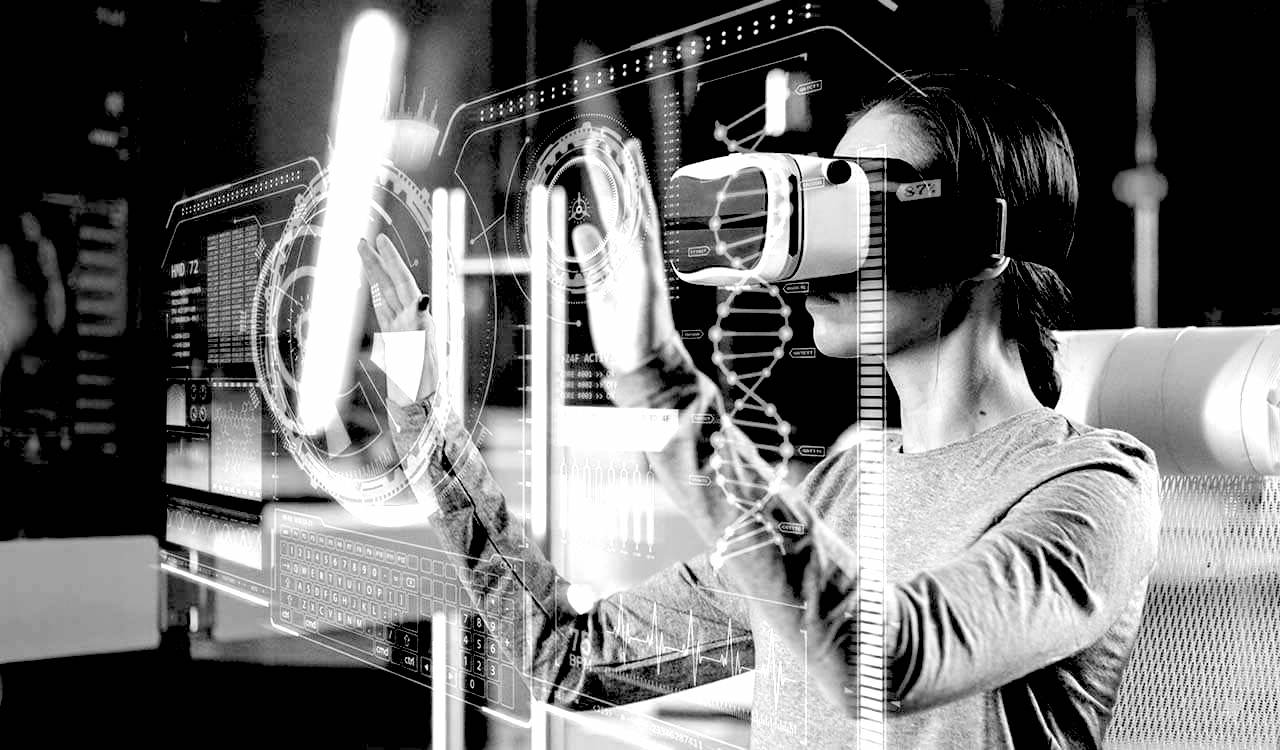
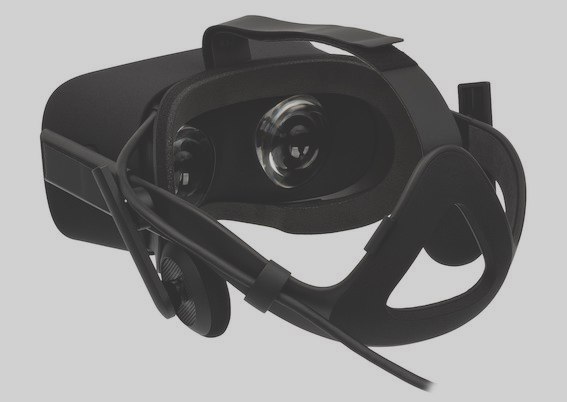
image from TECH
EXPLAINED: VIRTUAL REALITY.
今日では上の映像ような、VRヘッドセット (Virtual reality headset)を装備したユーザーが、仮想的には外側にパネルがあるかのような「経験」をさせてくれてくれる。そしてその経験に対して、次なるリアリ ティを提示してくれるために、ヴァーチャルリアリティはリアルな経験のレパートリーである。つまりVRは白昼夢よりもより科学的基礎と実証と確度のあるリ アル提示の「経験」をさしてくれる。
もっとも元祖・懐疑論者のディヴィッ ド・ヒュームに 言わせれば、我々のリアル・リアリティというものは、ヴァーチャル・リアリティであり、眼球をまぶたの側からそっと押さえつけるだけで、目に見える世界は 歪んでみえ、我々がみている情報はすべて、脳で処理された画像を感じ取っているにすぎない。手に触ったという事実ですら、脳が手の情報をそのように処理し ているにすぎない。もっとも、ヒュームの懐疑論は、哲学的省察にひつようなものであり、日常生活に懐疑論をいちいち持ち込むなという意見もある(→「理性の綱渡り」)

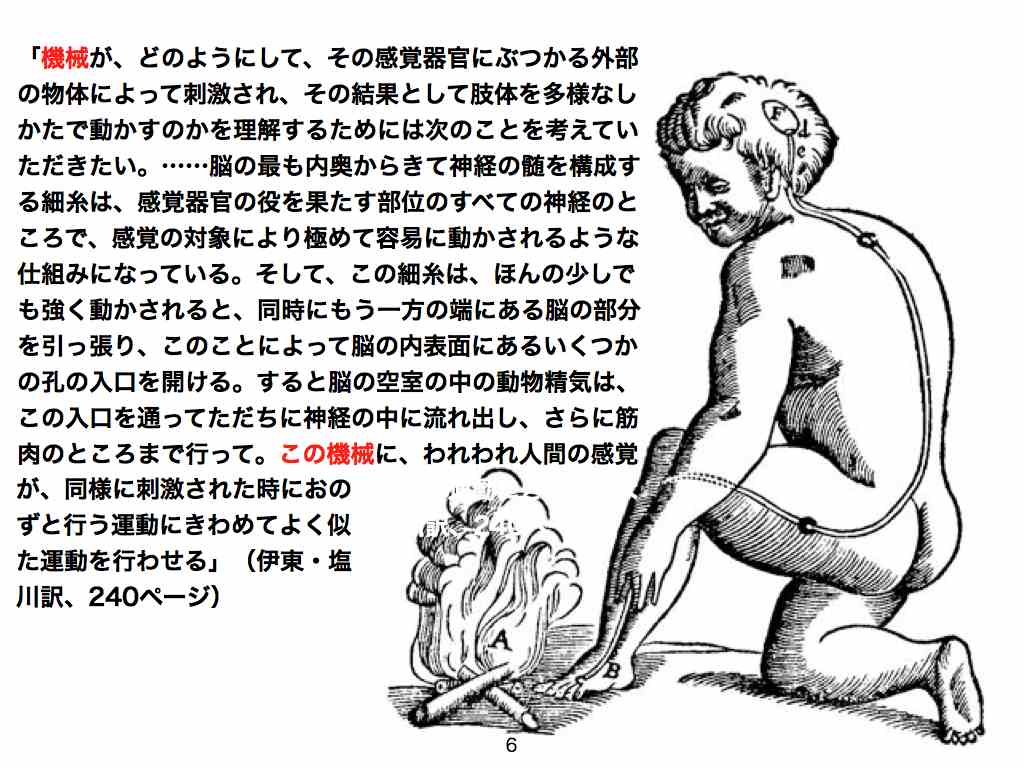



●ヴァーチャルリアリティ覚書(ネット記事の再掲) https://gigazine.net/news/20220114-second-life-founder-returns-metaverse/
| なんと「セカンドライフ」創業者がメタバース(Metaverse)の流行に合わせて復帰へ ビッグ・テックとして数えられるFacebookが社名を「Meta(日 本語版)」に変更してまで注力を掲げるなど、PCやネットワーク上に構築された3次元のバーチャル空間に参加 できるサービス「メタバース」が人気の高まりを見せています。この過熱ぶりに乗じてメタバースの先駆けとなった「セカンドライフ」の創業者が、再びセカン ドライフの運営に参加するという発表が行われました。 | Linden Lab, HIGH FIDELITY INVESTS IN SECOND LIFE. Second Life Founder Returns to Take On the Metaverse - WSJ 2022年1月13日、ボイスチャット向けのオーディオAPIなどを提供するHigh Fidelityがセカンドライフを運営するLinden Labに対して出資と分散コンピューティングの特許提供などを行うと発表しました。さらに、この出資に際してHigh FidelityのメタバースチームがLinden Labに合流するとのことで、Linden Labを辞任して以降はHigh Fidelityの創設者兼CEOとして活躍していたフィリップ・ローズデール氏がLinden Labに再加入すると明かされました。ローズデール氏はLinden Labを設立してインターネット規模の仮想世界を創造するという理念の下、セカンドライフを作成。2007年にはTIME誌の「世界で最も影響力のある 100人」にも選出されましたが、セカンドライフのブームが終わりを迎えた2008年にCEOを辞して会長職に就任。2010年には一時的にCEOに復帰 しましたが、2013年には完全に袂を分かってHigh Fidelityを設立していました。 メタバースに参入する企業が増えだしたのが2020年だったことを考えると、セカンドライフが誕生した「2003年」というのは時期尚早すぎたという評が 存在します。セカンドライフは当時からデジタルコンテンツの制作・売買やコミュニケーション、社会活動シミュレーションなどを実現しており、土地の売買や 株取引などができるだけでなく、ストリップクラブなどの性的サービスすら存在します。 セカンドライフはゲーム内の通貨を現実世界の通貨に変換するシステム(いわゆるリアルマネートレード)をすでに実装しているという他社のメタバースにはな い特徴が存在しており、今後もゲーム内の社会的・経済的要素などをさらに改善してユーザー数増加に取り組むとのこと。 |
| メ
タバースという言葉は定義が曖昧であり[29]、専門用語風であり、投機的であり、しばしばバズワードであるとされる[30]。投資性が高いらし
いが、それが何か不透明である、という状況に乗じて、「『乗り遅れたくない』『金もうけのチャンス』という焦りを利用したメタバースについての情報商材、
専門家、悪徳商法も次々に現れており、にわか専門家、オンラインサロンが大量出現しているという[31]。メタバースを商材に掲げる企業が雨後の筍のよう
に乱立している様について、Roblox関連企業のCEOは、「私が思い出すのは、インターネットの黎明期だ。どこを見てもインターネット一色で、誰もが
自称『インターネット企業』だった」と初期のインターネットバブルに状況をなぞらえている[32]。中国ではメタバースが「金を産みそうな未来技術」とし
て言葉が一人歩きし、ひともうけを企むインフルエンサーや企業が湧き出て収拾がつかなくなっている。中国検索エンジン大手百度の副総裁は2021年12月
に開かれた自社のイベントで、「メタバースでひともうけを考える企業は多く、どれが本物か見分けがつかない状態だ。今は期待値だけが上がっており、来年後
半か再来年にはバブルがはじけると信じている」と苛立ちを隠さなかったという[32]。 |
"A brain–computer interface (BCI), sometimes called a brain–machine interface (BMI), is a direct communication pathway between the brain's electrical activity and an external device, most commonly a computer or robotic limb. BCIs are often directed at researching, mapping, assisting, augmenting, or repairing human cognitive or sensory-motor functions.[1] Implementations of BCIs range from non-invasive (EEG, MEG, EOG, MRI) and partially invasive (ECoG and endovascular) to invasive (microelectrode array), based on how close electrodes get to brain tissue.[2] Research on BCIs began in the 1970s by Jacques Vidal at the University of California, Los Angeles (UCLA) under a grant from the National Science Foundation, followed by a contract from DARPA.[3][4] The Vidal's 1973 paper marks the first appearance of the expression brain–computer interface in scientific literature. Due to the cortical plasticity of the brain, signals from implanted prostheses can, after adaptation, be handled by the brain like natural sensor or effector channels.[5] Following years of animal experimentation, the first neuroprosthetic devices implanted in humans appeared in the mid-1990s. Recently, studies in human-computer interaction via the application of machine learning to statistical temporal features extracted from the frontal lobe (EEG brainwave) data has had high levels of success in classifying mental states (Relaxed, Neutral, Concentrating),[6] mental emotional states (Negative, Neutral, Positive)[7] and thalamocortical dysrhythmia.[8]"
「「ブレイン・マシン・インターフェース(BMI)
と呼ばれることもあるブレイン・コンピューター・インターフェース(BCI)は、脳の電気的活動と外部機器(最も一般的なものはコンピューターやロボット
の手足)との間の直接的な通信経路である。BCIの実装は、非侵襲的なもの(EEG、MEG、EOG、MRI)、部分的に侵襲的なもの(ECoG、血管
内)から、電極を脳組織にどれだけ近づけるかに基づく侵襲的なもの(微小電極アレイ)まで様々である。 [2]
BCIの研究は、1970年代にカリフォルニア大学ロサンゼルス校(UCLA)のジャック・ヴィダル(Jacques
Vidal)により、全米科学財団からの助成金とDARPAからの契約に基づいて始まった。脳の皮質の可塑性により、移植された人工器官からの信号は、適
応後、自然なセンサーやエフェクター・チャンネルのように脳によって扱われるようになる[5]。長年にわたる動物実験の後、1990年代半ばに、人間に移
植された最初の神経人工器官が登場した。最近では、前頭葉(脳波)データから抽出された統計的な時間的特徴に機械学習を適用したヒューマンコンピュータイ
ンタラクションの研究が、精神状態(リラックス、ニュートラル、集中)[6]、精神的感情状態(ネガティブ、ニュートラル、ポジティブ)[7]、視床皮質
不整脈[8]の分類に高い成功を収めている。」
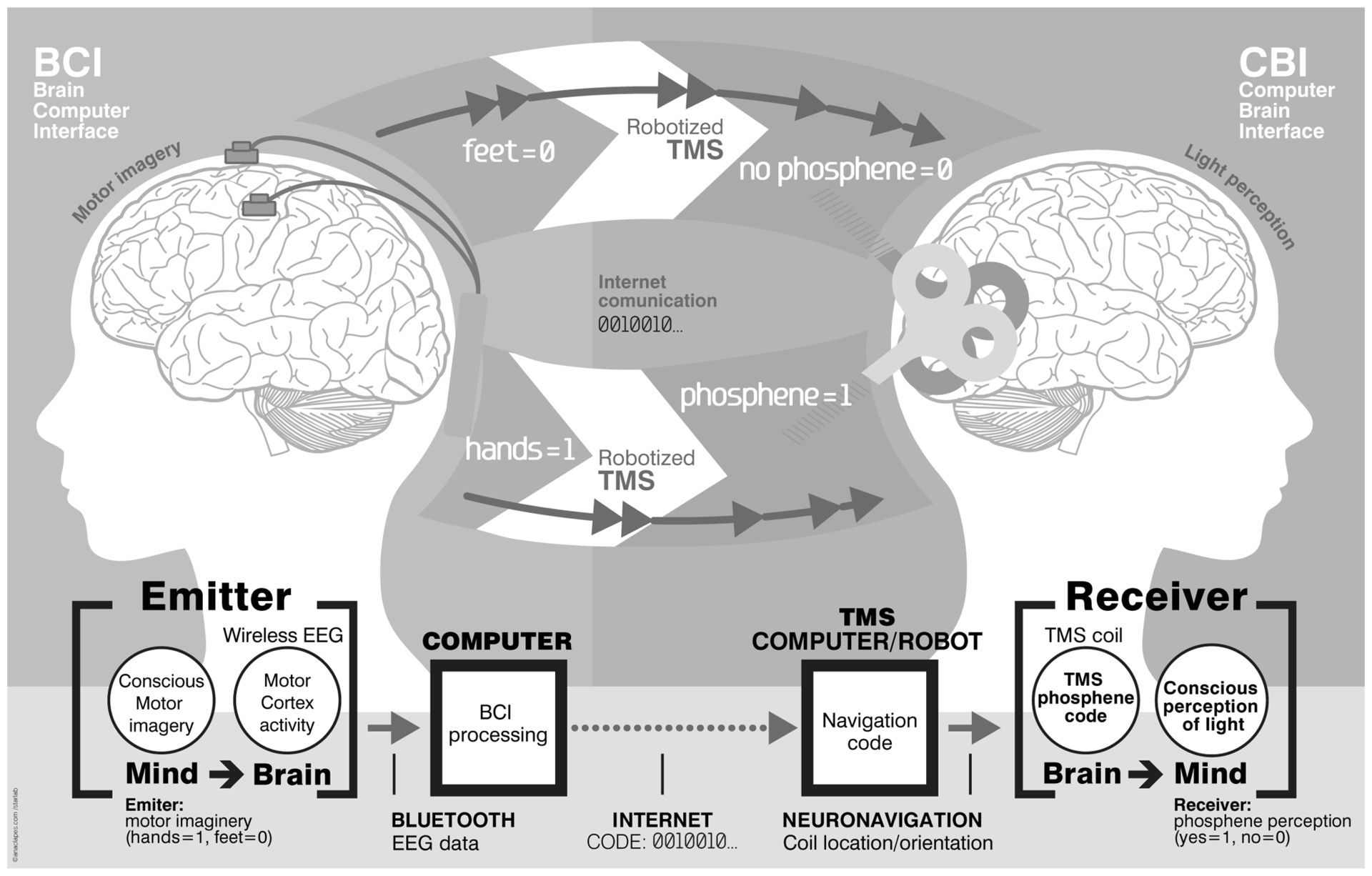
Carles Grau, Romuald
Ginhoux, Alejandro Riera, Thanh Lam Nguyen, Hubert Chauvat, Michel
Berg, Julià L. Amengual, Alvaro Pascual-Leone, Giulio Ruffini -
http://journals.plos.org/plosone/article?id=10.1371/journal.pone.0105225
◎ヴァーチャルリアリティにおける「反復と差異」
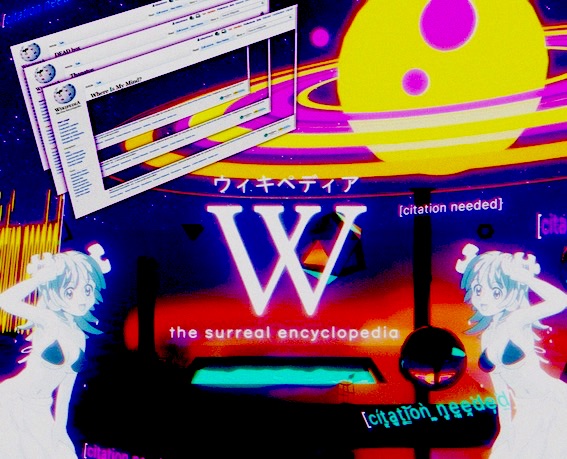
Post-Internet movements are responsible for Internet-centric microgenres and subcultures such as vaporwave[Amarca, Nico (March 1, 2016). "From Bucket Hats to Pokémon: Breaking Down Yung Lean's Style". High Snobiety.]
●「差異と反復」は移転しました!!!
リンク
文献
その他の情報


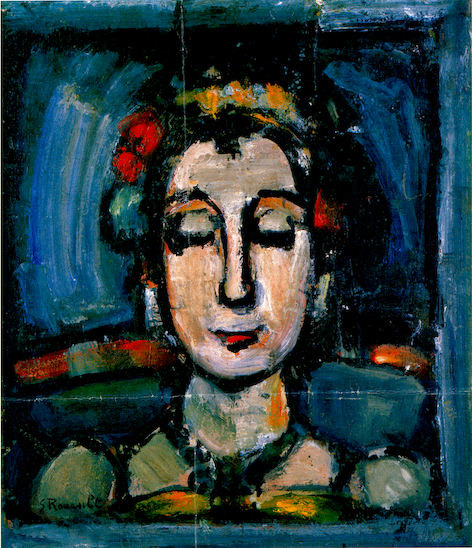

++
Copyleft,
CC, Mitzub'ixi Quq Chi'j, 1996-2099